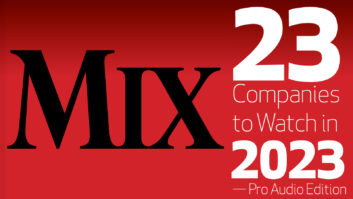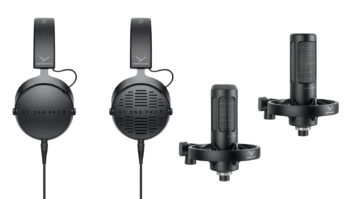
There is a scene in the film Moscow on the Hudson in which RobinWilliams’ character, a defecting Russian circus musician, stumbles intoa supermarket and, confronted with the American cornucopia of productchoices after a lifetime under the Soviet system, breaks down crying.It’s easy to understand his pain: On the one hand, such plenty aftersuch paucity would certainly provoke tears of joy; but the bewildermentbrought on by so many choices could also account for tears ofconfusion.
You may have noticed that your local audio retailer has begun tolook a bit like a supermarket recently. While the pro audio industry’stransformation into a commodities market has been well-documented, theeffects of this shift are still taking shape.
The technological foundations for this shift were laid in the early1980s with the arrival of Tascam and Fostex 4- and 8-track recorders.These affordable multitracks spawned a personal recording industry thathas affected (or infected, depending upon your point of view) everyaspect of the recording industry. Retail changed in response, startingin 1988, when musical instrument store Manny’s Music bought Manhattanpro audio dealer Audio Techniques to establish an independent pro audioarm to augment the bursting back room of the store on West 48th Street.Two years later Sam Ash, whose Manhattan store was located directlyacross the street, opened its own pro audio division.
A decade later, the focus has shifted to Florida, where MARS andThoroughbred Music are headquartered, and Southern California, home toGuitar Center-the model of expanded mom-and-pop stores grown intonationwide chains-augmented by catalog sales companies such asMusician’s Friend and B&H (which has opened a much larger Manhattanstore). You can now purchase a $20,000 mixer and a $250 guitar underthe same roof. More to the point, you can also purchase a $250 mixerand $20,000 guitar in the same place, which illustrates the radicalchanges wrought by technology, production economies and an MTV-fed,mass-market culture.
One way manufacturers have reacted to these market changes is byadapting their product development to fit new models. “There’s more ofeverything, but a plethora of the same things,” is how Mike Descoteau,a sales director at Dale Pro Audio, describes the situation. “When onecompany has a hit product, it seems like the others all follow and youa get this screaming redundancy of products. [At the same time], all ofthe manufacturers want you to do one-stop shopping with them.”Certainly, it seems as if products come in waves now; several years agoat the AES convention it looked like the year of the powered monitor,and more recently the large-diaphragm microphone has become the BeanieBaby(tm) of pro audio.
A wide range of choices is ostensibly a good thing. Butmanufacturers seem to be following a path of vertical integration, inwhich each company offers products for any and all applications. Insome cases, manufacturers have gone the OEM route, purchasing orlicensing a design and putting their brand on it after a few changes.The key, some will tell you off the record, is adapting their productlines to fit the direction in which retail is moving. “The whole thingis about building brand awareness,” says one marketing VP on conditionof anonymity. “When someone walks into one of these mega-stores, youwant them to see your equipment all over the place-mixers, outboardgear, speaker, microphones, you name it. That’s the way retail isgoing. Manufacturers have to react to that.”
Chicken or egg? Did technology change retail, or is it the other wayaround? Certainly, manufacturers are adapting to new sales formulas.But they may also be feeling the effect of changes in the business ofpro audio. Ham Brosious, a co-founder of Audio Techniques who nowspecializes in equipment brokering and studio liquidations (at one timehe was the leading MCI console and tape machine salesman in the U.S.),told me once, “The basis for a store like Audio Techniques was eroding.Pro audio dealers wanted exclusive sales on a few consoles, and now youhad 15 stores in the New York area that sold Mackies. A lot of proaudio dealerships were based on a few product lines, and themanufacturers realized there was no longer an advantage in having anexclusive distributorship. We had MCI, and Martin had Otari. As Otarimoved to other distribution methods and as MCI faded, the dealershipsthat relied on having them exclusively suffered.”
The question for manufacturers and dealers, or retailers, then, ishow to respond to changes, no matter the driving force. Expansion byacquisition seems to be the logical step at this point. MARS began withfour ACE Music stores purchased by company founder Mark Begelman. Proaudio companies have also grown their pro audio divisions viaacquisitions. Take a look at Harman Industries, which over the yearsexpanded its holdings from speaker manufacturer JBL to console makerSoundcraft, to tape machine maker Studer to live sound processor BSS.Or use Peavey as a model-a major vertically integrated manufacturerthat recently bought a majority interest in console/amplifier makerCrest Audio. Such vertically oriented operations provide the economiesof scale needed to produce a lot of equipment cost-effectively. Andcommodification is the result. So the forces acting upon manufacturersare similar to the forces shaping retail. You can’t change one withoutchanging the other.
The fundamental shift in retail is now taking place on a massivescale-between MARS, Thoroughbred and Guitar Center, there are close to50 megastores selling combinations of pro audio and music gear. Allhave announced that they will add more stores, and all are addingtangential products and services to their bread-and-butter-equipmentsales.
Individual stores have also transformed into technology bazaars: In1997 audio/video retailer B&H Superstore (see sidebar) opened a new35,000-square-foot facility on Ninth Avenue in Manhattan, with fourhands-on suites designed by John Storyk for customer evaluation ofequipment and A/B comparisons using interactive touch-screen monitors.The store also includes a 100-plus-seat seminar room to host monthlyeducational events and seminars for staff and customers. Acknowledgingthe wide variety of both customers and technology these days, storemanager Gary Eisenberger observed that the design concept “enablescustomers to access product knowledge totally at their own pace,”adding that the store functions as “a year-round AES convention.”Underscoring the degree to which this technology now parallels otherretail environments, Eisenberger says that B&H has “created theultimate pro audio, pro video and photo shopping experience.”
There’s plenty of action in other areas, too: Gibson, maker of fineguitars for more than 100 years, has embarked on a venture to open 50Gibson Guitar Cafes across the U.S.; Fender has a clothing line. Thebusiness of making or selling either pro audio or MI equipment willnever resemble the cottage industry it once was.
None of this ensures that homogenization will be the rule in thefuture. The industry is still heavily populated with smallmanufacturers with limited product lines, targeting small niches. “Andthat’s the most exciting part of any trade show these days,” saysDescoteau, “finding the guy with a ten-by-ten booth on the perimeter ofthe floor who’s making and selling something new. They’re outthere.”






